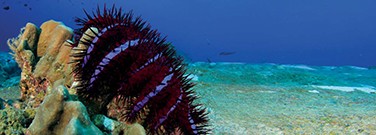Fish Poop Study Aims to Control Starfish That Destroy Coral Reefs
By Gina Wynn
Until recently, many biologists believed there were few coral reef inhabitants that could make a meal out of crown-of-thorns (COT) starfish (Acanthaster planci) because of their sharp spiny limbs and toxic venom. But new research on fish poop and gut contents has uncovered that it’s already on the menu for at least 18 coral reef fish species.
Australian Institute of Marine Science Biologist Frederieke Kroon, PhD, led the study that was published in Scientific Reports. She collaborated on the work with researchers from the Australian Institute of Marine Science (AIMS), the Commonwealth Scientific and Industrial Research Organisation (CSIRO) Land and Water, and the Great Barrier Reef Marine Park Authority.
"Our results strongly indicate that direct fish predation on crown-of-thorns may well be more common than is currently appreciated," Kroon said.
Destructive Dinner Habits
These findings are important because they could help biologists protect delicate coral reefs from destruction from COT feeding habits. Native to the Australian Great Barrier Reef, these gigantic starfish that can span 2.5 feet in diameter and wield 14 to 21 weaponlike arms can devour 20 to 32 feet of living coral a year, according to The Washington Post article “Scientists tackle starfish plagues on endangered Great Barrier Reef” by Allison Hirschlag.
A COT eats coral polyps by climbing onto a coral colony and ejecting its stomach out through its mouth, spreading it over the coral. Digestive stomach enzymes liquify and absorb the polyp tissue and leave only a calcified skeleton behind. Because of this devastating behavior, this species poses the second-biggest threat to reef life after tropical cyclones.
COT population surges that have occurred three times since 1962 have caused extensive damage to reefs that are already being impacted by climate change. But if natural predators of the starfish can help keep populations from growing, biologists can take steps to safeguard these species that serve as natural protection for the reef.
Starfish for Supper
Before the study, scientists knew of only one definite natural predator of COT — a mollusk called the Giant Triton (Charonia tritonis). The team’s research confirmed that others include Spangled Emperor (Lethrinus nebulosus), Redthroat Emperor (Lethrinus miniatus), and Blackspotted Puffer (Arothron nigropunctatus). They also found nine other species that had not been previously known to feed on COT, including Neon Damsel (Pomacentrus coelistis), Redspot Emperor (Lethrinus lentjan), and the Blackspot Snapper (Lutjanus fulviflama).
The group identified these species by applying a genetic marker unique for COT to samples of fish poop and gut contents to detect the presence of starfish DNA. They used the method on samples from 678 fish from 101 species gathered from reefs that experienced starfish outbreaks, according to an AIMS news release.
Harmonious Coexistence
Their results shed light on the natural environmental checks that are in place to keep the coral reef ecosystem balanced as long as they are not upset by external forces. Darren Cameron, co-author of the study and director of the COTS Control Program at the Great Barrier Reef Marine Park Authority, cautions that care should be taken to monitor fishing in these areas.
"A number of the fish species shown to feed on these starfish are caught by commercial and recreational fisheries,” he noted, “highlighting the importance of marine park zoning and effective fisheries management in controlling crown-of-thorns starfish across the Great Barrier Reef."
Discussion Questions
- Name some other things that are harmful to coral reefs.
- How can overfishing affect the environment?
Vocabulary
- DNA
- Ecosystem
- Enzyme
- Predator
- Zoning

